Abstract
Honey and other bee products have been used for food and therapeutic purposes since ancient times. There are many varieties of honey with time-proven therapeutic properties, used in both traditional and modern medicine, along with various beekeeping products. In this study, conducted based on the dissemination of a questionnaire with 43 questions, an evaluation of the consumption of different types of honey for both food and therapeutic purposes was carried out. Hence, the frequency of the consumption of honey for food purposes was evaluated, as well as the pharmaceutical forms of honey and bee products utilized for therapeutic purposes, the population’s trust in their therapeutic potential, and their trust in the quality of bee products among the Romanian population. After processing the data, 917 responses were recorded, and it was found that the preferred types of honey were black locust (83.5%), multi-floral (81.9%), and linden (74.9%), and among the other bee products, the most consumed were propolis (44.2%) and bee pollen (29.2%). Regarding the use of honey as a sweetener, the majority of the respondents considered honey to be the healthiest option (81.7%), and regarding the use of honey for therapeutic purposes, most of the respondents stated that they used honey to strengthen the immune system (65.4%), as well as for skin treatment, laxative action, or energizing. The centralization and processing of the collected responses indicated a considerable level of readiness related to the increase in honey consumption in particular, but there is a need for the dissemination of effective information related to the nutritional and therapeutic value of beekeeping products to the population.
1. Introduction
Honey is one of the oldest panaceas utilized by humans of all time, used internally and externally for its therapeutic effects; it can almost be said that honey is much older than the history of medicine itself (Figure 1).
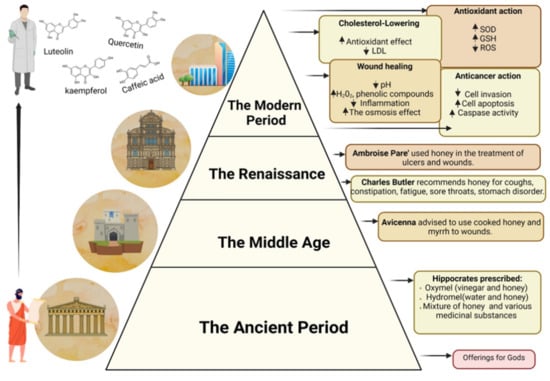
Figure 1.
Honey and its therapeutic uses by historical period (created with BioRender web application).
For a long time, honey was the main product used as a sweetener by ancient populations. The popularization of beet sugar and the development of its production in the 19th century led to the ranking of honey in a secondary position. Honey was used by the ancient people as both a sweetener and a gift to the gods, an ingredient for embalming, and in the composition of medicinal preparations and different perfumes. The evidence of the use of honey since ancient times is found in the Sumerian clay tablets, the Egyptian papyri (1900–1250 BC), the Veda (Hindu scripture), the Quran, and the writings of the Jewish culture. In the Bible, the promised Canaan is likened to, “the land where milk and honey flow”. The 16th century BC Egyptian papyrus known as the Ebers Papyrus has many honey-based preparations used especially in the healing of wounds and diseases of the digestive tract [1]. In ancient Greece, it was a primordial tradition to offer honey to the gods and spirits of death. Additionally, honey was not only used to honor the gods but also given to heroes, so before performing in the arena, the gladiators were given honey to provide them strength and energy. A drink widely used at that time in ancient Greece was made from honey and unfermented grape juice. Therefore, Hippocrates, the great Greek scientist, recommended numerous diets based on honey; for example, oxymel (made from vinegar and honey) was effective for pain and mead (made from water and honey) for thirst and revitalization. Additionally, Hippocrates used honey for various treatments such as healing wounds, treating baldness, for a laxative action, relieving cough and sore throat, as well as for treating eye diseases. Honey was also used for eye diseases in Ayurvedic medicine, as it was believed that its daily application to the eyes improves vision [2].
The Roman civilization dedicated a cult to honey, as they were convinced that honey was part of the food enjoyed by the dead, so they frequently chose to embalm them in honey. In addition to its use in the worship of the gods, honey was used in cooking and medicine. Thus, Dioscorides recommended its use to heal wounds, Galen suggested it for combating tissue inflammation, and Pliny, the famous erudite of the Roman Empire, described honey as a remedy for ear pain and diseases [3,4,5,6].
In addition to its use in traditional medicine, honey has recently been subjected to laboratory research to demonstrate its properties in modern medicine. The therapeutic profile of honey is complex since it is a combination of about 200 compounds, consisting of different types of sugars, free amino acids, proteins, essential minerals, water, enzymes, vitamins, pigments, and various phenolic compounds [7,8,9,10].
Recent studies have demonstrated the antitumor, anti-inflammatory, antioxidant, and antimicrobial effects of honey [11,12,13,14,15]. It has been observed that, in some types of honey, through the enzyme glucose oxidase secreted by bees, the glucose in the honey is transformed into gluconic acid and hydrogen peroxide, compounds tolerated by the tissues that are effective against bacteria, thus favoring the healing process of scarring [16,17,18,19].
The composition of honey is extremely complex; flavonoids and polyphenols have strong antioxidant effects through their ability to donate hydrogen groups to eliminate free radicals, thus reducing oxidative stress. Among the most well-known compounds are caffeic acid, quercetin, and chlorogenic acid, which prevent the formation of free radicals through chelation [20,21,22].
The current research on honey is intensively focused on its powerful antibacterial activity, highlighting its use in modern medicine as an attractive alternative treatment for combating multi-resistant pathogens. The antibacterial activity of honey is attributed to both its physical factors (a low pH and high osmolarity) and chemical factors (the presence of hydrogen peroxide, different phenolic acids, methylglyoxal, the antibacterial peptide defensin-1 of bees) [23,24,25].
Honey and other bee products have been proven over time to have immunomodulatory and detoxifying properties [26,27], particularly important in the context of the increasing levels of pollution and the consumption of foods rich in synthetic additives or medicinal substances with unwanted side effects [28,29].
The composition of honey is extremely complex, and it depends on a huge number of factors such as environmental factors, the floral source, the bee species that produced the honey, as well as the manner of its processing by humans [30,31]. The consequences of strong industrialization and urban overcrowding that have led to the degradation of the environment affect the quality of both terrestrial [32] and marine food products [33,34]. Unfortunately, neither honey nor beekeeping products are safe from the effects of environmental pollution. Numerous studies prove that rain can also affect bee products and endanger the safety of consumers [35,36,37].
At the same time, we must also consider the fact that honey is one of the most falsified food products; as a result, consumers generally avoid buying honey from sources that do not provide quality assurance [38,39].
Romania has a tradition in the consumption of honey and bee products related to its reasonably widespread beekeeping activity.
Considering that honey is a natural, nutritious sweetener with time-proven therapeutic properties, we sought to evaluate the consumption and therapeutic use of honey and bee products at the level of the Romanian population, as well as the factors that influence the decision to purchase and consume these products and the population’s confidence in the nutritional and therapeutic properties of honey and beekeeping products.
2. Materials and Methods
2.1. Study Design
Between 3 June and 16 July 2022, a study of the Romanian population was conducted based on a questionnaire disseminated online by using the Google Forms web survey platform. A cross-sectional survey design was used in order to identify the preferences related to the consumption of different varieties of honey and beekeeping products. The link to the online survey was shared through social media (social networks) and the institutional mailing lists of students and professional organizations from Romania. The participants were also asked to share the link to the questionnaire with their colleagues and friends. The questionnaire contains 43 items structured on anthropometric and social data, the evaluation of the frequency of the consumption of different types of honey for food purposes, the evaluation of the consumption of honey and bee products for therapeutic purposes, and the evaluation of the factors that limit the consumption of honey and bee products among the Romanian population. Microsoft Excel was used to download the final database.
The minimum age limit required to participate in the survey was 18 years old. Participation in the study was entirely voluntary and anonymous. From the beginning, the volunteers agreeing to take part in this survey were both notified of the purpose of this study and ensured of the confidentiality (sensitive personal data) of this research in compliance with the General Data Protection Regulation (GDPR) in order to be able to use and publish the results.
2.2. Questionnaire Validation
In the first stage, the questionnaire was tested in the pilot phase on a group of 150 people over the age of 18. The testing results of the pilot phase of the questionnaire were analyzed by a group of 5 experts meant for content validation and optimization. The content validity ratio (CVR) and the content validity index (CVI) were calculated [40,41,42].
Based on the 5 expert opinions, the irrelevant items were removed, and the modifications were made according to the remaining items in order to make them more accurate and to increase clarity [43].
The internal consistency of the questionnaire was determined using Cronbach’s α coefficient. For the present questionnaire, the value of Cronbach’s α was 0.81. This value indicates a good internal consistency and that the scale is reliable [43,44].
The final form of the questionnaire is presented in Appendix A.
2.3. Statistical Analysis
All the categorical characteristics from our study were qualitatively analyzed and are expressed as percentages (%) and numbers (n). Additionally, the numerical characteristics were transformed into qualitative variables (such as age and body mass index (BMI) variables) and are expressed by percentages (%) and numbers (n).
Statistical analysis was performed using the open-source software R (version 4.1.3) [45]. Pearson’s chi-square (χ2) test or Fisher’s exact test was used for small-sized samples to analyze the relationship between the categorical variables and thus to find the patterns of dietary changes. Additionally, a post hoc pairwise comparison was required to compare the levels of each factor involved (gender, age group, BMI group) that influenced the consumption of honey [46]. At a significance level of alpha = 0.05, we considered that the association between the variables was statistically significant, and for post hoc comparations, this was determined by applying the Bonferroni-corrected alpha level.
3. Results
3.1. Socio-Demographic and Anthropometric Data
A total of 925 responses were obtained after the dissemination of the questionnaire in an online environment, of which 917 were valid answers (the answers with incorrect anthropometric data were eliminated). Overall, 83.2% of the valid answers belonged to people from urban environments and 16.8% to people from rural settings, and of these, 77.5% were women, and 22.5% were men.
The anthropometric data (weight and height) were used to calculate the BMI by using the Quetelet equation (body mass (kg)/height (m2)) and interpreted according to the criteria of the World Health Organization [47]. Most of those who participated in the survey had normal weight (54%), while 6.6% were underweight, 26% overweight, and 13.4% were obese [48]. In Table 1, the socio-demographic characteristics of the participants are presented.

Table 1.
Socio-demographic characteristics of participants (n = 917).
The anthropometric data showed higher percentages of overweight (41%) and obese (18%) among the male respondents than their female counterparts (Figure 2a), for whom the ratio of overweight people was 22%, and that of obese people was 12% (p = 0.001). On the other hand, underweight people were found to be more among the female respondents (8%) than the male participants (1%).
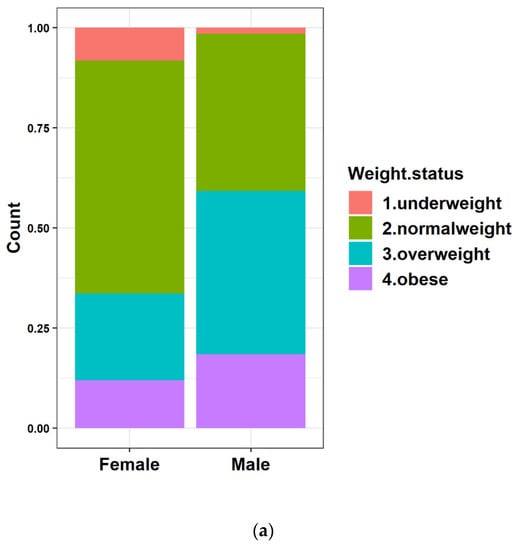
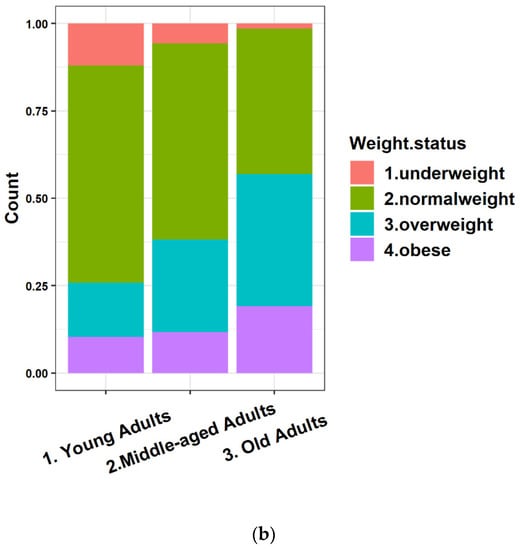
Figure 2.
Weight status by (a) gender and (b) age group.
Additionally, from the processing of the anthropometric data (Figure 2b), the highest percentages of overweight (38%) and obese (19%) people were noted among the elderly respondents (over 50 years old), compared with the young (overweight 15%, obese 10%) or middle-aged respondents (26% overweight, 12% obese). Instead, most of the underweight (12%) or regular weight (62%) people were found among the young respondents aged under 30, compared with the middle-aged respondents (underweight 6%, normal weight 56%) and the older ones (underweight 1%, normal weight 42%), p = 0.001.
3.2. Consumption Preferences of Honey
Regarding the tendency to consume honey in breakfast dishes (Figure 3), it was found that the highest percentage of those who sometimes consumed belonged to the underweight respondents (67%), and those who consumed it frequently were the regular weight (22% of them) and overweight respondents (23%), (p = 0.457).
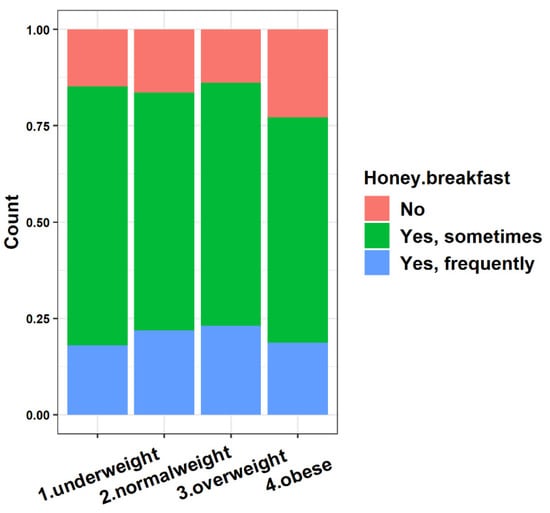
Figure 3.
Consumption of honey at breakfast according to BMI.
In the case of snacks (Figure 4), most people who used to include honey sometimes belonged to the underweight people (70% of them) and the overweight people (68% of them), and those who frequently consumed honey as snacks were the regular weight and obese people (14%), p = 0.739.
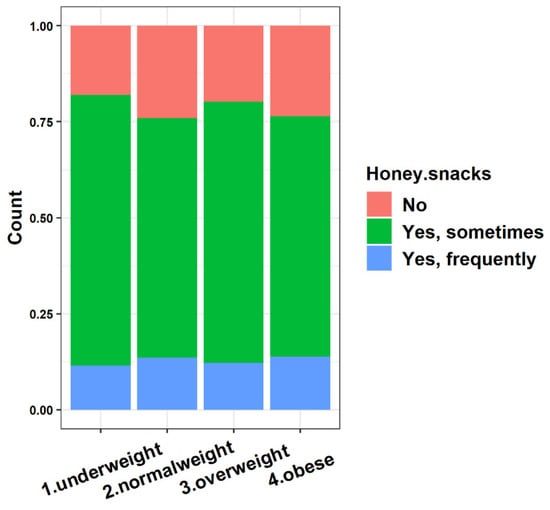
Figure 4.
Consumption of honey in snacks according to BMI.
The processed data highlighted close consumption trends for honey in soft drinks for all body weight groups (p = 0.322) (Figure 5).
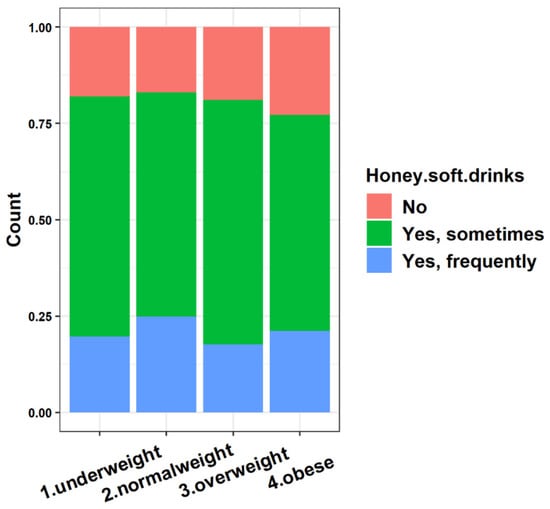
Figure 5.
Consumption of honey in soft drinks according to BMI.
Regarding the frequency of honey consumption (Figure 6a), the most frequent consumption was found among the normal weight respondents (daily), as revealed by the processing of the data collected based on the questionnaire, and the least among the obese and underweight people (p = 0.006). Therefore, as shown in Figure 6a, the frequency of honey consumed once was quantified as follows: 1—no consumption, 2—very rarely, 3—once a week, 4—two to three times a week, and 5—daily.
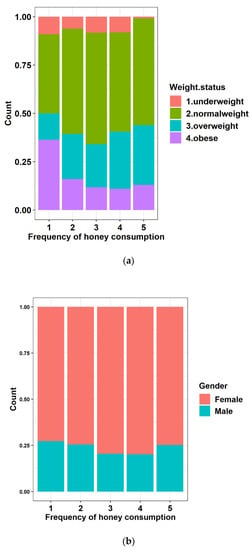
Figure 6.
Frequency of honey consumption by (a) body weight groups (1—no consumption, 2—very rarely, 3—once a week, 4—two to three times a week, and 5—daily) and (b) gender (1—no consumption, 2—one teaspoon, 3—two to three teaspoons, 4—four to five tea-spoons, and 5—more than five teaspoons).
The female respondents tended to use honey more often than their male counterparts, as seen in Figure 6b (p = 0.001).
The amount of honey consumed once was quantified as follows: 1—no consumption, 2—one teaspoon, 3—two to three teaspoons, 4—four to five teaspoons, and 5—more than five teaspoons. As a result, it was found that most respondents, regardless of their body weight, consumed 2–3 teaspoons of honey once (p = 0.248) (Figure 7a).
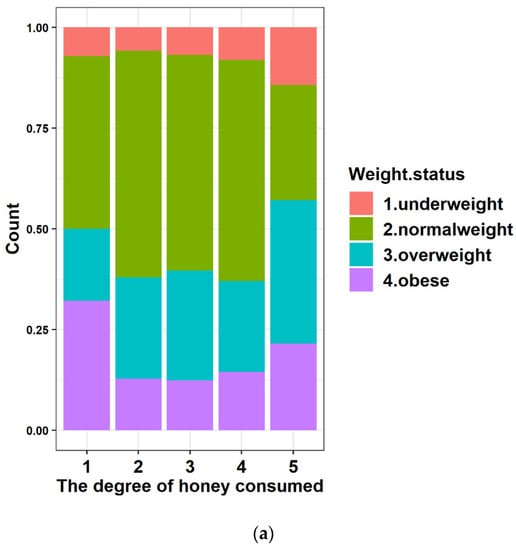
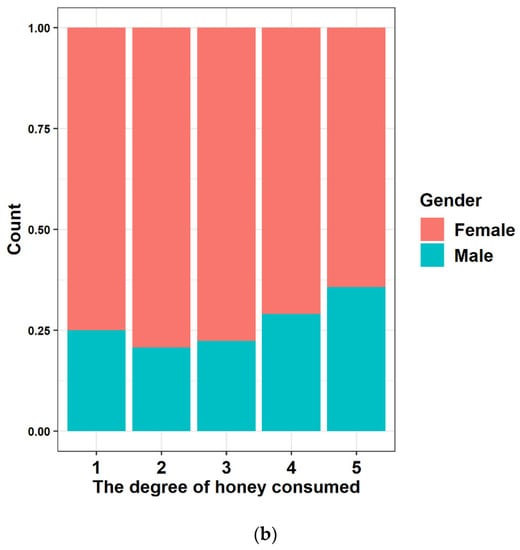
Figure 7.
The amount of honey consumed by (a) weight group (1—no consumption, 2—one teaspoon, 3—two to three teaspoons, 4—four to five tea-spoons, and 5—more than five teaspoons) and (b) gender (1—no consumption, 2—one teaspoon, 3—two to three teaspoons, 4—four to five tea-spoons, and 5—more than five teaspoons).
The male respondents tended to consume honey in large quantities at a single dose, as seen in Figure 7b (p = 0.001).
After processing the collected data (Figure 8a), an increased preference for brown and white sugar was noted in the case of the underweight and obese people (around 60%). In both situations, the most frequently consumed sweetener was white sugar (over 35%), and the highest preference for using honey as a sweetener was noted among the normal weight and overweight people (p = 0.008). Stevia was consumed the most by the underweight people.
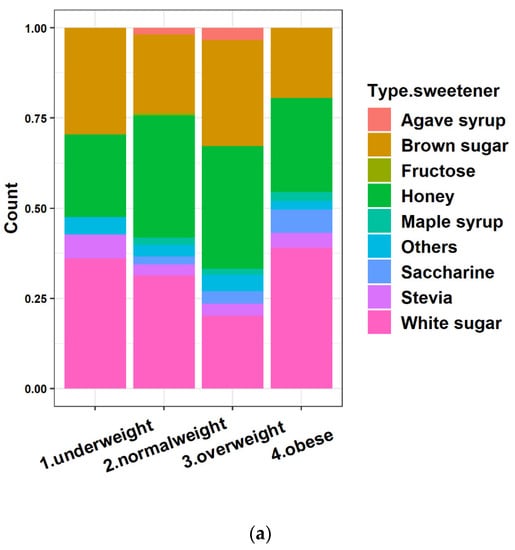
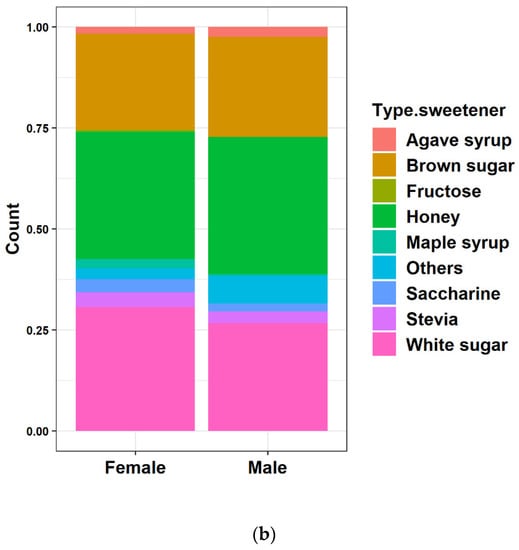
Figure 8.
The type of sweetener consumed by (a) weight group and (b) gender.
Honey was preferred as a sweetener more by the men who completed the questionnaire, along with brown sugar and agave syrup, but the data were not conclusive because, in general, men did not participate in large numbers for filling out the questionnaire, and we could deduce that those who wanted to fill in the questionnaire were those who consumed honey.
In comparison, the female respondents (Figure 8b), had higher preferences for white sugar and Stevia than the male participants (p = 0.001).
Considering the growing interest and trust of consumers in the therapeutic properties of honey and beekeeping products, it is necessary to increase the amount of correct information provided to the population and at the mass media level in relation to the ways of exploiting the therapeutic potential of beekeeping products, as well as the reliable sources of supply with quality products. As we noticed from the recorded answers, the respondents gained very little information from the mass media, and they received most of their information from the materials distributed on the Internet (Figure 9).

Figure 9.
Sources of information for consumers of beekeeping products.
There is a wide range of supplements and dermato-cosmetic products with bee products intended for the treatment of various types of ailments. The specialized literature and medical practice have confirmed a multitude of benefits for human health regarding the use of bee products. Unfortunately, according to the centralized data from the distributed questionnaire, the use of bee products in therapy was more focused on strengthening the immune system and the treatment of respiratory diseases (Figure 10b), and the supplements most used in treatments were lozenges and syrups (Figure 10a). The situation is better with dermato-cosmetic products, as most of the products included in the questionnaire presented a good margin in the respondents’ preferences (Figure 10c).
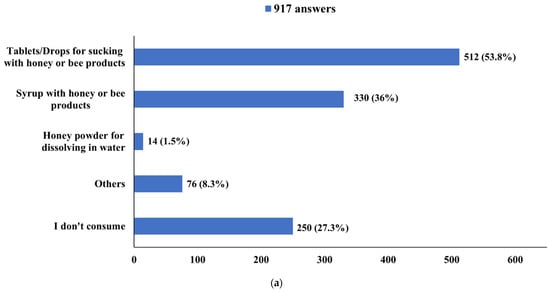
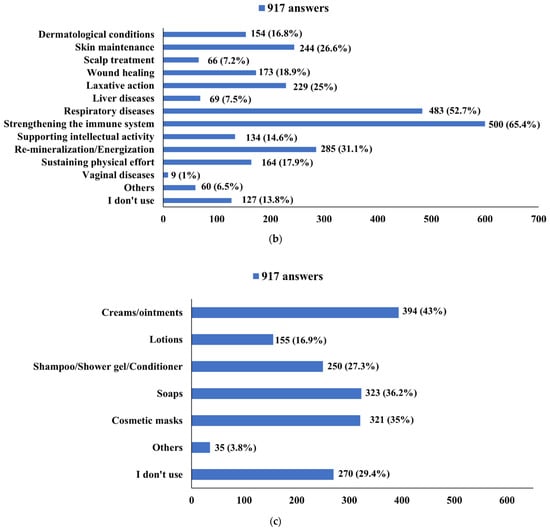
Figure 10.
Ways to capitalize on the therapeutic potential of beekeeping products: supplements with bee products (a); diseases treated with bee products (b); dermato-cosmetic products with bee products (c).
From the analysis of the restrictions related to the consumption of honey and beekeeping products, we found the following: in general, the percentage of the respondents in the analyzed sample who did not consume honey frequently was around 18–20%, and the causes mostly concerned the diet (Figure 11a) rather than medical reasons (Figure 11b,c).
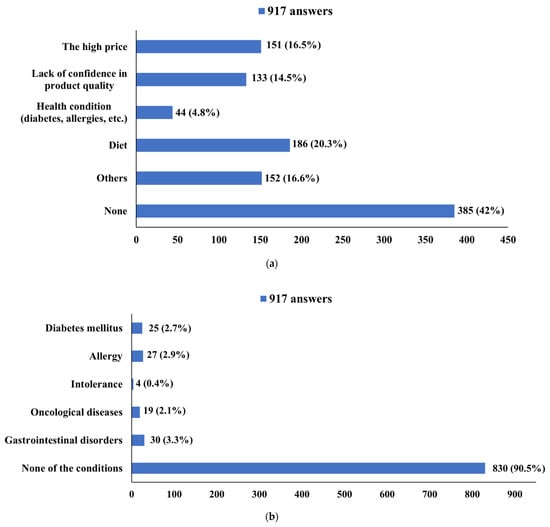
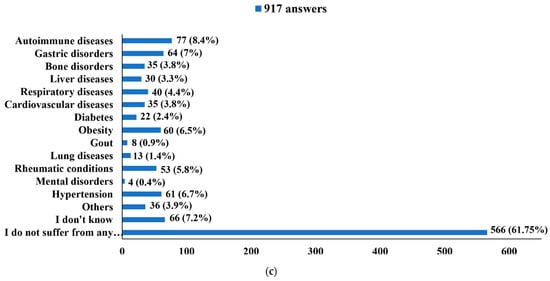
Figure 11.
Restrictions on the consumption of bee products: (a) personal reasons; (b) special conditions; (c) chronic conditions.
According to the collected data, it was found that the respondents were aware of all the pollutants that can affect the quality of beekeeping products and implicitly impact the health of the consumers, but the majority believed that pesticides represented the predominant contaminant (Figure 12).
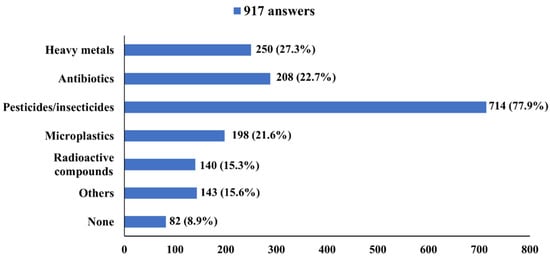
Figure 12.
Pollutants that can affect the quality of beekeeping products.
4. Discussion
From the statistical analysis of the data collected from our questionnaire, a greater tendency to use honey as a sweetener was noted among the regular weight respondents than the overweight or obese people, the latter of whom predominantly preferred brown or white sugar. On the other hand, honey has nutritional properties superior to those of sugar, and a greater sweetening capacity; hence, the need for its minor consumption implies a lower caloric intake. It is known that the use of honey as a natural sweetener brings superior benefits to the consumer. These aspects, highlighted by our evaluation of the questionnaire data, follow the clinical studies carried out on obese laboratory animals or obese human subjects, which demonstrated the effects of honey consumption in reducing body weight, improving the lipid profile, and preventing metabolic syndrome. All these beneficial effects generated by the consumption of honey are attributed to the complex composition of this nutritious natural food, superior to refined carbohydrates and mainly consisting of minerals and compounds with antioxidant action that improve lipid metabolism and insulin resistance [49,50,51].
Regarding consumption preferences, it can be noted from the recorded responses that black locust honey was the most appreciated (38.3%), along with multi-floral honey (28.2%) and linden honey (17%). The most consumed types of honey were the same three: black locust honey (83.5%), multi-floral honey (81.9%), and linden honey (74.9%).
The respondents declared that they mainly preferred to buy honey directly from producers (87.1%) and less from supermarkets (17.8%), health food stores (16.9%), or pharmacies (6.9%). This is probably due to their lack of confidence in the quality of the products sold in the respective units, knowing that honey is one of the most falsified products. In fact, 75.7% of the respondents did not trust the quality of honey and beekeeping products sold in supermarkets, while only 30.3% answered that they trust the quality of the products sold in other apicultural commercial spaces, and 45.4% considered that only some of the products sold were of good quality. It cannot be said that honey is not a product consumed by Romanians because more than 60% of the respondents declared that they sometimes added honey in breakfast preparations, snacks, or soft drinks, and a percentage of approximately 20% consumed it frequently. Among the non-alcoholic beverages associated with honey, lemonade (84.2% of the respondents) and tea (74.9% of the respondents) were mentioned the most. In the case of coffee, only 20.2% of the respondents said they sweetened it with honey.
As for the amount of honey consumed in general, it was two to three teaspoons (49.3% of the respondents), and 39.4% consumed only one teaspoon, which confirms the fact that, due to having a sweetening capacity greater than sugar, honey has the tendency to be consumed in a smaller amount than sugar, and therefore, there is a lower risk of excessive caloric intake. Regarding the frequency of consumption, 33.6% of the respondents declared that they consumed honey two to three times a week, 26.6% very rarely, 24% only once a week, and 13.4% daily. The percentage of respondents who did not consume honey at all was 2.4%.
Concerning the association of honey with other bee products, 51% of the respondents declared that they did not associate honey with other bee products, and 41.5% only rarely did. This is also explained by the fact that only 22.1% of the respondents considered that the combination of honey with other bee products was effective, while 37.8% did not know, and 10.1% considered that this combination did not represent an advantage for health. Therefore, it is clear that there is a need to better inform the public about the nutritional and therapeutic potential of bee products, and the possibilities of combining them with honey in different situations. In this sense, not only specialists should get involved but also beekeepers who are directly interested in their promotion. Apart from honey, the most consumed bee products were propolis (44.2% of the respondents) and bee pollen (29.2% of the respondents).
Regarding the consumption of honey and bee products, 34.2% of the respondents stated that they intended to increase it, 32.4% indicated that it was possible, and 20.2% did not know. As regards the quality of honey as a sweetener, 81.7% of the respondents considered it one of the healthiest sweeteners, and 95.7% trusted its therapeutic properties.
The most important sources of information regarding the therapeutic properties of honey were the Internet (53.7% of the respondents used it), producers (38.6%), and health specialists (37.2%).
As for the consumption of supplements with honey or bee products, only 13.4% of the respondents frequently used them, and 56.8% sometimes used them; the most consumed products were lozenges (55.8%) and syrups (36%). Among the dermato-cosmetic preparations with bee products, the most used, according to the answers received, were creams, soaps, and cosmetic masks.
In the sample of those questioned, 19.8% frequently used honey or bee products for therapeutic purposes, while 62.1% sometimes used them, mainly for strengthening the immune system and respiratory diseases but very little for healing wounds. However, it is known that honey is an excellent healing agent. From these data, we find that it is necessary to promote information related to other therapeutic effects of honey and bee products, especially since 57.8% of the respondents claimed to know that the constant consumption of quality honey and bee products would have a beneficial effect on their health, and 51.6% believed that administering these products together with traditional medication would help in better and faster recovery. The main reasons that restricted the consumption of honey and beekeeping products among the respondents were the diet, the lack of confidence in the quality of the products, and the high price. Although, in general, there are no restrictions imposed by the state of health, 90.5% of the respondents declared that they had no health problems that would prevent them from consuming honey.
The participants in the questionnaire were aware of the fact that honey and beekeeping products can be affected by pollution (69.2%), and the main contaminants were considered to be pesticides. That is why when buying beekeeping products, they put more emphasis on quality (87.4%) and less on price or promotional offers. The quality of the container was also considered, as 62.3% of the respondents believed that the packaging can affect the quality of beekeeping products, and 77.3% chose beekeeping products packaged in glass containers.
There are studies that evaluate the consumption of honey and bee products in the specialized literature. In a study from Turkey, published in 2019, a poor adherence of consumers was found for beekeeping products other than honey due to the lack of information related to the therapeutic potential of these products and also a lack of consumer confidence in the purchase of honey from certain distribution units due to the increased risk of falsification, data that are consistent with the results of our study [52]. Another study carried out based on the dissemination of a questionnaire, published in 2020, analyzed the reasons that restricted the use of honey for therapeutic purposes among the female population in Germany and highlighted a close correlation between the quality of honey and the degree of its use in therapy so that, in general, among the sorts certified, the organic ones were the most used for therapeutic purposes [53]. In 2021, a study was also published based on a questionnaire among the population in Indonesia that aimed to identify the frequency of consumption and the reasons that restrict the consumption of honey among the population of the West Java region. This study also found the need for an increase in the level of information, especially on the part of beekeepers and the beekeeping industry, in order to increase the consumption of honey, considering the special therapeutic and nutritional value of this natural product [54].
This study has some limitations. Although the distribution of the questionnaire did not limit participation to only persons under 18 years of age, in the sample surveyed, the percentage of male respondents was quite low. The explanation for the low rate of male respondents would be their lower availability to complete the questionnaire.
5. Conclusions
The questionnaire results of this study will allow professionals to better understand the factors that influence consumers’ decisions related to the purchase and consumption of honey or bee products, the identification of key problems, and the proposal of solutions to increase the consumption of these products.
Considering the clear benefits of honey consumption on the human body, there is a need to publicize the superiority of honey over refined sweeteners in terms of their nutritional value and intensify the efforts of nutrition specialists to increase the population’s confidence in the healthy and therapeutic potential of honey and bee products.
From the processing of the data collected on the basis of the disseminated questionnaire, limited exploitation was observed regarding the therapeutic potential of honey and other bee products, largely due to food restrictions more generated by eating habits than by health problems, which means that a more intense promotion of the therapeutic benefits of beekeeping products, especially in the mass media, can lead to the increased use of these products.
The quality of the honey assortments sold in different commercial units must also be considered. As a result, in this direction, it is necessary to intensify quality control and implement much harsher sanctions to discourage any form of falsification, thus increasing consumer confidence in the quality of beekeeping products sold in accredited units.
Author Contributions
Conceptualization, M.M., E.O. and D.D.; methodology, C.-B.I.-M., C.N. and K.Z.; software, M.G.; validation, S.M.N., D.-E.D., H.M., F.N.R. and E.A.O.; formal analysis, M.G. and N.M.; investigation, K.Z., N.D.G. and A.M.M.; resources, D.-E.D., H.M. and F.N.R.; data curation, S.M.N. and A.M.M.; writing—original draft preparation, M.M.; writing—review and editing, E.O.; visualization, C.-B.I.-M.; supervision, E.O.; project administration, M.M.; funding acquisition, D.D. All authors have read and agreed to the published version of the manuscript.
Funding
This research received no external funding.
Institutional Review Board Statement
Not applicable.
Informed Consent Statement
Not applicable.
Data Availability Statement
Not applicable.
Conflicts of Interest
The authors declare no conflict of interest.
Appendix A
Questionnaire to evaluate the consumption and therapeutic use of honey and beekeeping products among the Romanian population
Personal data
1. Please mention your age (in years):
2. Please mention your gender:
- Male
- Feminine
- Others
3. Please indicate the geographical region in which you live:
- Banat
- Crisana
- Maramureș
- Bucovina
- Moldova
- Dobrogea
- Muntenia
- Oltenia
- Transylvania
4. Please mention your place of current residence:
- City
- Commune/Village
5. Please mention the level of education:
- General/primary studies
- Secondary education (baccalaureate degree)
- Post-secondary studies
- Higher education (bachelor’s degree)
- Postgraduate studies (master’s degree, residency, doctorate, other specializations)
Anthropometric data
6. Please mention your weight (in kg):
7. Please mention your height (in cm):
Food honey
8. What kind of honey do you prefer to consume?
- Linden Honey
- Acacia Honey (Black locust Honey)
- Rapeseed Honey
- Multifloral Honey
- Forest Honey
- Manuka Honey
- Tualang Honey
- Others
- I don’t consume
9. Which of the following types of honey have you consumed? (several variants)
- Linden Honey
- Acacia Honey (Black locust Honey)
- Rapeseed Honey
- Multifloral Honey
- Forest Honey
- Manuka Honey
- Tualang Honey
- Others
- I don’t consume
10. Where do you purchase honey or bee products? (several variants)
- Pharmacy
- Ceiling/ Natural stores
- Producers
- Fairs/Exhibitions
- Supermarket
- I don’t consume
11. Do you consume honey or bee products in the dishes served at breakfast?
- Yes, frequently
- Yes, sometimes
- No
12. Do you consume honey or bee products in snacks?
- Yes, frequently
- Yes, sometimes
- No
13. Do you consume honey or bee products in soft drinks?
- Yes, frequently
- Yes, sometimes
- No
14. What types of soft drinks do you pair with honey? (several variants)
- Tea
- Lemonade
- Juices
- Coffee
- Water
- Others
- I do not associate
15. In what quantity do you usually consume honey?
- A teaspoon
- Two–three teaspoons
- Four to five teaspoons
- More than five teaspoons
- I don’t consume
16. How often do you usually consume honey?
- Daily
- Two to three times a week
- Once a week
- Very rarely
- I don’t consume
17. Do you consume honey together with other bee products?
- Yes, frequently
- Yes, rarely
- No
18. What other bee products do you consume besides honey? (several variants)
- Bee pollen
- Propolis
- Royal jelly
- Pasture
- I don’t consume
19. Do you think that honey is more effective when you consume it together with other bee products?
- Yes
- Probably
- I don’t know
- No
20. Do you intend to consume more honey or bee products in the future?
- Yes
- Probably
- I don’t know
- No
- Honey as sweetener
21. Which type of sweeteners do you use the most from the following variants?
- White sugar
- Brown sugar
- Honey
- Saccharine
- Fructose
- Glucose
- Stevia
- Maple syrup
- Agave syrup
- Others
22. Which of the following sweeteners do you consider to be the healthiest? (several variants)
- White sugar
- Brown sugar
- Honey
- Saccharine
- Fructose
- Glucose
- Stevia
- Maple syrup
- Agave syrup
- None of them
Honey therapeutic properties
23. Where do you find out about the therapeutic properties of honey or bee products? (several variants)
- Mass-media or Internet
- Manufacturer
- Friends/Acquaintances
- Specialists (doctors, pharmacists)
- Specialized magazines
- Specialized books
- Other sources
24. Do you trust the therapeutic properties of honey or bee products?
- Yes
- No
25. Do you use food supplements containing honey or bee products?
- Yes, frequently
- Yes, sometimes
- I don’t consume
26. Which supplements containing honey or bee products do you use most often? (several variants)
- Tablets/Drops for sucking with honey or bee products
- Syrup with honey or bee products
- Honey powder for dissolving in water
- Others
- I don’t consume
Honey/bee products use
27. Do you consider honey or bee products to be natural products with special therapeutic properties?
- Yes
- I don’t know
- No
28. Do you consider that the types of honey or beekeeping products sold are of good quality?
- Yes
- I don’t know
- No
29. Do you trust the quality of honey assortments or bee products sold in supermarkets?
- Yes
- No
30. Have you used honey or bee products for the treatment/healing of any disease?
- Yes, frequently
- Yes, sometimes
- Never
31. In what type of conditions have you used honey or bee products? (several variants)
- Dermatological conditions
- Skin maintenance
- Scalp treatment
- Wound healing
- Laxative action
- Liver diseases
- Respiratory diseases
- Strengthening the immune system
- Supporting intellectual activity
- Re-mineralization/Energization
- Sustaining physical effort
- Vaginal diseases
- Others
- I don’t use
32. Do you think that a constant consumption of quality honey or bee products would have a beneficial effect on your health?
- Yes
- Probably
- I don’t know
- I don’t consume
33. Do you think that a consumption of honey or bee products combined with classical medication would help a better recovery against other diseases?
- Yes
- Probably
- I don’t know
- No
34. What types of dermato-cosmetic products that contain honey or bee products do you use? (several variants)
- Creams/ointments
- Lotions
- Shampoo/Shower gel/Conditioner
- Soaps
- Cosmetic masks
- Others
- I don’t use
Honey restrictions
35. What are the reasons that prevent you from consuming honey in the amount you want? (several variants)
- The high price
- Lack of confidence in product quality
- Health condition (diabetes, allergies, etc.)
- Diet
- Others
36. Do you suffer from any of the following conditions that prevent you from consuming honey? (several variants)
- Diabetes mellitus
- Allergy
- Intolerance
- Oncological diseases
- Gastrointestinal disorders
- None of the conditions
37. What type of chronic conditions do you have? (several variants)
- Autoimmune diseases
- Gastric disorders
- Bone disorders
- Liver diseases
- Respiratory diseases
- Cardiovascular diseases
- Diabetes
- Obesity
- Gout
- Lung diseases
- Rheumatic conditions
- Mental disorders
- Hypertension
- Others
- I don’t know
- I do not suffer from any medical condition
Honey and pollution
38. Do you think honey or bee products can be affected by pollution?
- Yes
- Probably
- I don’t know
- No
39. When you buy honey or a bee product, what influences your choice?
- Product quality
- The price
- Promotional offers
- I don’t consume
40. Do you think that honey or bee products are affected by the increasing degree of pollution in the environment?
- Yes
- Possible
- I don’t know
- No
41. What contaminants do you think can be found in honey or bee products? (several variants)
- Heavy metals
- Antibiotics
- Pesticides/insecticides
- Microplastics
- Radioactive compounds
- Others
- None
42. Do you think that the type of container influences in any way the quality of honey or bee products?
- Yes
- Possible
- I don’t know
- No
43. When you buy honey or bee products do you consider the type of container used, glass or plastic?
- I always choose glass containers
- I did not consider this aspect
- I do not consider this aspect important
- I don’t consume
References
- Kuropatnicki, A.K.; Kłósek, M.; Kucharzewski, M. Honey as medicine: Historical perspectives. J. Apicult. Res. 2018, 57, 113–118. [Google Scholar] [CrossRef]
- Eteraf-Oskouei, T.; Najafi, M. Traditional and Modern Uses of Natural Honey in Human Diseases: A Review. Iran. J. Basic Med. Sci. 2013, 16, 731–742. [Google Scholar] [CrossRef] [PubMed]
- Zumla, A.; Lulat, A. Honey: A remedy rediscovered. J. R. Soc. Med. 1989, 82, 384–385. [Google Scholar] [CrossRef] [PubMed]
- Samarghandian, S.; Farkhondeh, T.; Samini, F. Honey and Health: A Review of Recent Clinical Research. Pharmacogn. Res. 2017, 9, 121–127. [Google Scholar] [CrossRef]
- Bansal, V.; Medhi, B.; Pandhi, P. Honey-A Remedy Rediscovered and Its Therapeutic Utility. Kathmandu Univ. Med. J. 2005, 3, 305–309. [Google Scholar]
- Viel, C.; Doré, J.-C. Histoire et Emplois Du Miel, de l’hydromel et Des Produits de La Ruche. Rev. Hist. Pharm. 2003, 91, 7–20. [Google Scholar] [CrossRef]
- Escuredo, O.; Míguez, M.; Fernández-González, M.; Carmen Seijo, M. Nutritional value and antioxidant activity of honeys produced in a European Atlantic area. Food Chem. 2013, 138, 851–856. [Google Scholar] [CrossRef]
- Alvarez-Suarez, J.M.; Giampieri, F.; Battino, M. Honey as a source of dietary antioxidants: Structures, bioavailability and evidence of protective effects against human chronic diseases. Curr. Med. Chem. 2013, 20, 621–638. [Google Scholar] [CrossRef]
- White, J.W.; Doner, L.W. Honey Composition and Properties. Beekeep. U.S. Agric. 1980, 335, 82–91. [Google Scholar]
- Bogdanov, S.; Jurendic, T.; Sieber, R.; Gallmann, P. Honey for nutrition and health: A review. J. Am. Coll. Nutr. 2008, 27, 677–689. [Google Scholar] [CrossRef]
- Miguel, M.G.; Antunes, M.D.; Faleiro, M.L. Honey as a Complementary Medicine. Integr. Med. Insights. 2017, 12, 1–15. [Google Scholar] [CrossRef] [PubMed]
- Ahmed, S.; Sulaiman, S.A.; Othman, N.H. Oral administration of Tualang and Manuka honeys modulates breast cancer progression in Sprague-Dawley rats model. Evid. Based Complement. Altern. Med. 2017, 2017, 5904361. [Google Scholar] [CrossRef] [PubMed]
- Afrin, S.; Forbes-Hernandez, T.Y.; Gasparrini, M.; Bompadre, S.; Quiles, J.L.; Sanna, G.; Spano, N.; Giampieri, F.; Battino, M. Strawberry-tree honey induces growth inhibition of human colon cancer cells and increases ROS generation: A comparison with Manuka honey. Int. J. Mol. Sci. 2017, 18, 613. [Google Scholar] [CrossRef] [PubMed]
- Alvarez-Suarez, J.M.; Tulipani, S.; Romandini, S.; Bertoli, E.; Battino, M. Contribution of honey in nutrition and human health: A review. Med. J. Nutr. Metab. 2010, 3, 15–23. [Google Scholar] [CrossRef]
- Agbaje, E.O.; Ogunsanya, T.; Aiwerioba, O.I.R. Conventional use of honey as antibacterial agent. Ann. Afr. Med. 2006, 5, 79–81. [Google Scholar]
- Tashkandi, H. Honey in Wound Healing: An Updated Review. Open Life Sci. 2021, 16, 1091–1100. [Google Scholar] [CrossRef]
- Brischoux, S.; Desmoulière, A.; Faucher, Y.; Pautard, G.; Sparsa, A. Le Miel: Qualité, Produits et Utilisation. Actual. Pharm. 2013, 52, 26–31. [Google Scholar] [CrossRef]
- Saha, A.; Chattopadhyay, S.; Azam, M.D.; Sur, P.K. The role of honey in healing of bedsores in cancer patients. South Asian J. Cancer 2012, 1, 66–71. [Google Scholar] [CrossRef]
- Hashim, K.N.; Chin, K.Y.; Ahmad, F. The Mechanism of Honey in Reversing Metabolic Syndrome. Molecules 2021, 26, 808. [Google Scholar] [CrossRef]
- Cianciosi, D.; Forbes-Hernández, T.Y.; Afrin, S.; Gasparrini, M.; Reboredo-Rodriguez, P.; Manna, P.P.; Zhang, J.; Bravo Lamas, L.; Martínez Flórez, S.; Agudo Toyos, P.; et al. Phenolic Compounds in Honey and Their Associated Health Benefits: A Review. Molecules 2018, 23, 2322. [Google Scholar] [CrossRef]
- Khalil, M.I.; Sulaiman, S.A. The Potential Role of Honey and its Polyphenols in Preventing Heart Diseases: A Review. Afr. J. Tradit. Complement. Altern. Med. 2010, 7, 315–321. [Google Scholar] [CrossRef] [PubMed]
- Makedou, K.; Iliadis, S.; Kara, E.; Gogou, M.; Feslikidis, T.H.; Papageorgiou, G. Honey and its protective role against oxidation of human low density lipoproteins and total serum lipoproteins. Hippokratia 2012, 16, 287. [Google Scholar] [PubMed]
- Yupanqui Mieles, J.; Vyas, C.; Aslan, E.; Humphreys, G.; Diver, C.; Bartolo, P. Honey: An Advanced Antimicrobial and Wound Healing Biomaterial for Tissue Engineering Applications. Pharmaceutics 2022, 14, 1663. [Google Scholar] [CrossRef] [PubMed]
- Stagos, D.; Soulitsiotis, N.; Tsadila, C.; Papaeconomou, S.; Arvanitis, C.; Ntontos, A.; Karkanta, F.; Adamou-Androulaki, S.; Petrotos, K.; Spandidos, D.A.; et al. Antibacterial and Antioxidant Activity of Different Types of Honey Derived from Mount Olympus in Greece. Int. J. Mol. Med. 2018, 42, 726–734. [Google Scholar] [CrossRef] [PubMed]
- Hossain, M.L.; Lim, L.Y.; Hammer, K.; Hettiarachchi, D.; Locher, C. Honey-Based Medicinal Formulations: A Critical Review. Appl. Sci. 2021, 11, 5159. [Google Scholar] [CrossRef]
- McLoone, P.; Warnock, M.; Fyfe, L. Honey: An immunomodulatory agent for disorders of the skin. Food Agric. Immunol. 2016, 27, 338–349. [Google Scholar] [CrossRef]
- Bogdanov, S. Honey in medicine: A review. Bee Prod. Sci. 2017, 1–28. Available online: http://www.bee-hexagon.net/ (accessed on 4 August 2022).
- Paula Neto, H.A.; Ausina, P.; Gomez, L.S.; Leandro, J.G.B.; Zancan, P.; Sola-Penna, M. Effects of Food Additives on Immune Cells As Contributors to Body Weight Gain and Immune-Mediated Metabolic Dysregulation. Front. Immunol. 2017, 8, 1478. [Google Scholar] [CrossRef] [PubMed]
- Ioniţă, A.C.; Ghica, M.; Moroşan, E.; Nicolescu, F.; Mititelu, M. In vitro effects of some synthesized aminoacetanilide n’-substituted on human leukocytes separated from peripheral blood. Farmacia 2019, 67, 684–690. [Google Scholar] [CrossRef]
- Bogdanov, S.; Haldimann, M.; Luginbühl, W.; Gallmann, P. Minerals in honey: Environmental, geographical and botanical aspects. J. Apic. Res. 2007, 46, 269–275. [Google Scholar] [CrossRef]
- Solayman, M.; Islam, M.A.; Paul, S.; Ali, Y.; Khalil, M.I.; Alam, N.; Gan, S.H. Physicochemical properties, minerals, trace elements, and heavy metals in honey of different origins: A comprehensive review. Compr. Rev. Food Sci. Food Saf. 2016, 15, 219–233. [Google Scholar] [CrossRef] [PubMed]
- Mititelu, M.; Ghica, M.; Ionita, A.C.; Moroşan, E. The influence of heavy metals contamination in soil on the composition of some wild edible mushrooms. Farmacia 2019, 67, 398–404. [Google Scholar] [CrossRef]
- Mititelu, M.; Moroşan, E.; Neacsu, S.M.; Ioniţă, E.I. Research regarding the pollution degree from romanian Black Sea coast. Farmacia 2018, 66, 1059–1063. [Google Scholar] [CrossRef]
- Ionita, A.C.; Mititelu, M.; Moroşan, E. Analysis of heavy metals and organic pollutants from some Danube river fishes. Farmacia 2014, 62, 299–305. [Google Scholar]
- Ribeiro, R.D.; Mársico, E.T.; de Jesus, E.F.; da Silva Carneiro, C.; Júnior, C.A.; de Almeida, E.; Filho, V.F. Determination of trace elements in honey from different regions in Rio de Janeiro state (Brazil) by Total reflection X-ray fluorescence. J. Food Sci. 2014, 79, T738–T742. [Google Scholar] [CrossRef]
- Mititelu, M.; Udeanu, D.I.; Nedelescu, M.; Neacsu, S.M.; Nicoară, A.C.; Oprea, E.; Ghica, M. Quality Control of Different Types of Honey and Propolis Collected from Romanian Accredited Beekeepers and Consumer’s Risk Assessment. Crystals 2022, 12, 87. [Google Scholar] [CrossRef]
- Scivicco, M.; Squillante, J.; Velotto, S.; Esposito, F.; Cirillo, T.; Severino, L. Dietary exposure to heavy metals through polyfloral honey from Campania region (Italy). J. Food Compos. Anal. 2022, 114, 104748. [Google Scholar] [CrossRef]
- Fakhlaei, R.; Selamat, J.; Khatib, A.; Razis, A.F.A.; Sukor, R.; Ahmad, S.; Babadi, A.A. The Toxic Impact of Honey Adulteration: A Review. Foods 2020, 9, 1538. [Google Scholar] [CrossRef]
- Soares, S.; Amaral, J.S.; Oliveira, M.B.P.; Mafra, I. A comprehensive review on the main honey authentication issues: Production and origin. Compr. Rev. Food Sci. Food Saf. 2017, 16, 1072–1100. [Google Scholar] [CrossRef]
- Lawshe, C.H. A quantitative approach to content validity. Pers. Psychol. 1975, 28, 563–575. [Google Scholar] [CrossRef]
- Yusoff, M.S.B. ABC of Content Validation and Content Validity Index Calculation. Educ. Med. J. 2019, 11, 49–54. [Google Scholar] [CrossRef]
- Mititelu, M.; Stanciu, T.I.; Udeanu, D.I.; Popa, D.E.; Drăgănescu, D.; Cobelschi, C.; Grigore, N.D.; Pop, A.L.; Ghica, M. The impact of COVID-19 lockdown on the lifestyle and dietary patterns among romanian population. Farmacia 2021, 69, 1–11. [Google Scholar] [CrossRef]
- Năstăsescu, V.; Mititelu, M.; Stanciu, T.I.; Drăgănescu, D.; Grigore, N.D.; Udeanu, D.I.; Stanciu, G.; Neacșu, S.M.; Dinu-Pîrvu, C.E.; Oprea, E.; et al. Food Habits and Lifestyle of Romanians in the Context of the COVID-19 Pandemic. Nutrients 2022, 14, 504. [Google Scholar] [CrossRef] [PubMed]
- Deniz, M.S.; Alsaffar, A.A. Assessing the validity and reliability of a questionnaire on dietary fibre-related knowledge in a Turkish student population. J. Health Popul. Nutr. 2013, 31, 497–503. [Google Scholar] [CrossRef][Green Version]
- R Core Team. R: A Language and Environment for Statistical Computing; R Foundation for Statistical Computing: Vienna, Austria, 2022; Available online: https://www.R-project.org/ (accessed on 4 August 2022).
- Mair, P.; Wilcox, R. Robust Statistical Methods in R Using the WRS2 Package. Behav. Res. Methods 2020, 52, 464–488. [Google Scholar] [CrossRef]
- Branca, F.; Nikogosian, H.; Lobstein, T. World Health Organization. Regional Office for Europe. In The Challenge of Obesity in the WHO European Region and the Strategies for Response; WHO Regional Office for Europe: Copenhagen, Denmark, 2007; ISBN 9789289014083. [Google Scholar]
- Ashwell, M.; Gibson, S. Waist-to-height ratio as an indicator of early health risk: Simpler and more predictive than using a matrix based on BMI and waist circumference. BMJ Open 2016, 6, e010159. [Google Scholar] [CrossRef]
- Ugusman, A.; Shahrin, S.A.S.; Azizan, N.H.; Pillai, S.B.; Krishnan, K.; Salamt, N.; Aminuddin, A.; Hamid, A.A.; Kumar, J.; Mokhtar, M.H. Role of Honey in Obesity Management: A Systematic Review. Front. Nutr. 2022, 9, 924097. [Google Scholar] [CrossRef]
- Samat, S.; Kanyan Enchang, F.; Nor Hussein, F.; Wan Ismail, W.I. 4-Week consumption of malaysian honey reduces excess weight gain and improves obesity-related parameters in high fat diet induced obese rats. Evid.-Based Complement. Altern. Med. 2017, 2017, 1342150. [Google Scholar] [CrossRef]
- Ramli, N.Z.; Chin, K.Y.; Zarkasi, K.A.; Ahmad, F. A Review on the Protective Effects of Honey against Metabolic Syndrome. Nutrients 2018, 10, 1009. [Google Scholar] [CrossRef]
- Aytop, Y.; Akbay, C.; Meral, H. Consumers Behavior Towards Bee Products Consumption in The Centre District ofKahramanmaras Province. KSU J. Agric. Nat. 2019, 22, 449–455. [Google Scholar] [CrossRef]
- Münstedt, K.; Männle, H.; Riepen, T. Survey of reasons why women utilize honey therapeutically, and reasons for not utilizing honey. Heliyon 2020, 6, e05231. [Google Scholar] [CrossRef] [PubMed]
- Purnomo, D.; Bunyamin, A.; Gunawan, W.; Faizah, N.A.; Danuwidjaja, T.G.; Rohman, L.N.; Annisa, R. Motivation, purpose, and purchasing frequency of honey consumption in West Java. IOP Conf. Ser. Earth Environ. Sci. 2021, 948, 012070. [Google Scholar] [CrossRef]
Publisher’s Note: MDPI stays neutral with regard to jurisdictional claims in published maps and institutional affiliations. |
© 2022 by the authors. Licensee MDPI, Basel, Switzerland. This article is an open access article distributed under the terms and conditions of the Creative Commons Attribution (CC BY) license (https://creativecommons.org/licenses/by/4.0/).